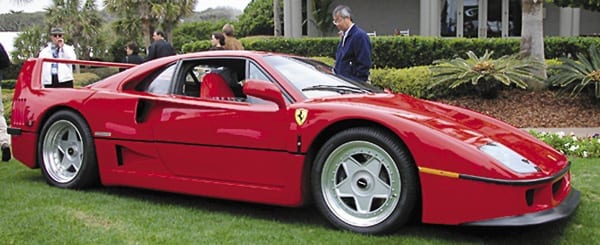Most of the Ferraris built in the last two decades have one thing in common with Toyota Camrys: After they leave the showroom floor, they become depreciating used cars. But three Ferraris built during that period stand out as having appreciated in value, the F40 and the F50, and the Enzo continues to sell well over its sticker price of $650,000, at least for now.
With only 210 factory-built, U.S.-spec F40s, 56 U.S.-spec F50s, and a probable 70 U.S.-spec Enzos scheduled to be built, these are the most exclusive Ferraris of their eras (1989–1992, 1995–1996 and 2003–2004, respectively). When new, all were pre-sold to those with the right connections to be at the top of lengthy waiting lists, and the financial wherewithal to pay from $300,000 to well over a million dollars for a car that they would, in all probability, rarely use.
When the F40, with its dramatic rear wing and promises of ultra-high performance, was announced, Ferrari fanatics, along with dealers and brokers, made the market look like feeding time at a shark exhibit. Despite a list price of around $300,000, the first few F40s were sold for over $1 million. Then prices dropped, bottoming out in the late 1990s at approximately $250,000–$275,000, before climbing to today’s $325,000–$375,000 level for an ultra low-mileage (under 1,000 miles) example.
With a twin-turbocharged V8 spitting out 478 hp, the F40’s 0–60 mph time is a mere 3.8 seconds and top speed is 196 mph. Even more, they look nasty and brutish like a proper supercar should.
A new F50 listed for about $450,000, but could only be leased, not purchased. Reportedly, Ferrari wanted to control the rampant price speculation, which they felt was affecting their credibility, and to protect themselves against product liability lawsuits.
As they came off lease and were sold into the secondary market, prices started to rise and never stopped. Today, an under-1,000-mile, well-documented and properly serviced U.S.-model F50 will easily bring $675,000. They have a 4.7-liter V12 that puts out 520 hp, achieve 0–60 mph in 3.7 seconds, and have a top speed of 202 mph.
The new bad boy on the block is the Enzo, Ferrari’s attempt to combine Star Wars styling with a real Formula One transmission that includes launch control. Other F1-derived features include ride-height control technology, active integrated aerodynamics, and built-in rear underbody diffusers or “tunnels.” Performance continues to climb. The 5998-cc, 660-hp V12 will rocket the Enzo from 0–60 mph in 3.6 seconds, and the top speed is 217.5 mph.
While the list price is about $650,000, the first few to change hands brought $1.2 million. However, the “bids” in the trade are dropping and the real sell price will probably be under $1 million by early next year.
Service problems on both the F40 and F50 are minimal, even when buying a 1,000-mile “garage queen,” but count on spending $5,000-plus in deferred maintenance on either an F40 or an F50.
The F40 cam-belt tensioner bearings tend to tighten up, causing the outside of the cam belt to scuff and gall against the tensioner, which leads to belt failure. The F40 bellhousing is magnesium and emits gases that will cause the clutch hydraulics to fail. Also, as F40s are now 10 years old, they are all are due for a complete water hose and rubber component replacement, regardless of miles.
The major problem with the F50 is its all-electronic instrument cluster. Prior to purchase, the car should be run through its entire start-up and electronics check sequence. If some part of the dashboard electronics is defective (not an uncommon occurrence), an authorized dealer will ship the dash back to Italy for a six-month, $10,000 repair. For those who would like faster service at a lower price, an independent Ferrari shop in the U.S. rebuilds the dashes at half the price and with a much faster turnaround.
The F50s also had a factory recall for a defective front main seal, and any car with ultra low miles may not have had the update. Finally, the belly pan on the F50 tends to hide leaks by holding dripping fluids, so it must be checked before purchase for pools of problems.
So far the Enzo has had five factory recalls related to a cooling fan update, the oil tank level dipstick, the front moveable flap connection, the F1 gearbox oil tank cap and the engine oil drain plug. All are covered under warranty.
Unlike vintage Ferraris, there should be no hidden problems on a no-accident, no-stories F40, F50 or Enzo. On the two earlier cars, whatever problems there are should be resolved by a $10,000 check-up (lunch money for those who can afford to own these cars). As for the Enzo, Ferrari will fix it for you under warranty.
Just as the performance-oriented, limited-production SWBs, TdFs and 275 GTBs have achieved a collectible status, these limited production late model cars will always be among the top tier of Ferraris. Of the three, I would suggest that at the current time the F40 is the best investment, as it has hit bottom and rebounded. The F50 seems relatively stable but fully priced, while the Enzo will undoubtedly fall some—if not much—in the near future. But over time, any of the three is a safe place to park some money, and taking one for a drive will surely be more fun than counting a handful stock certificates.


